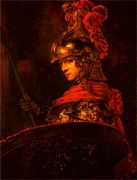Alexander III of Macedon (356 BCE – 323 BCE), commonly known as Alexander the Great, was a King of Makedonia who conquered the Achaemenid Empire. For this act, he is heralded as one of the most successful conquerors in history.
Biography[]
Rise to power[]
Alexander the Great's empire was backed by the Order of the Ancients, who had entrusted him with a Staff of Eden, explaining why Alexander was able to become so successful and undefeated.[2][3] In addition to the Staff, which reinforced his rule, Alexander also wielded the Trident of Eden in battle.[4]
During his successful conquest of the Achaemenid Empire, Alexander and his Macedonians entered Egypt, freeing the land from Persian influence and being saluted as liberators by the populacy. During his time in Egypt, Alexander visited the Oracle of Amun in Siwa, who prophesied his exploits and hailed him as Son of Ammon.[5]
Alexander also attempted to conquer the region of Cappadocia in Central Anatolia, but failed due to his lengthy military campaigns. Instead, an autonomous and independent kingdom was established, led by its own king outside of Alexander's empire.[6]
In October 331 BCE, after defeating the Persian king Darius III at the Battle of Gaugamela, Alexander entered the city of Babylon triumphantly and quickly captured it soon after.[7] Around 330 BCE, Alexander discovered the Herat Temple, an ancient structure built by the Isu, in Herat, Afghanistan, and built the Herat Citadel atop its remains.[8]
After conquering the Achaemenid Empire, Alexander set out to take over India's Punjab region. In the area between the Jhelum and Chenab Rivers, he encountered the prince Porus in what would become known as the Battle of the Hydaspes. Despite the Punjab force's numerical superiority, including 200 elephants, Alexander's troops flanked Porus' left side. The maneuver caused the elephants to panic, and Alexander's highly mobile cavalry proved too strong for the Punjab force. Presumably impressed with Porus' military elegance and spirit, Alexander allowed him to retain his kingdom after the battle. Porus became an ally and subordinate ruler of Alexander until sometime between 321 BCE and 315 BCE, when he was assassinated by Alexander's general Eudemus.[9]
During his reign, Alexander had established one of the largest empires in the world, and created a new Hellenistic civilization by leaving Greek colonists in his conquered lands. As he continued his conquest of Asia, a group of proto-Assassins realized that Alexander's success could not be caused by military prowess alone, suspecting that he held the Staff.[10]
Death[]
Thus, in 323 BCE, the proto-Assassin Iltani infiltrated Nebuchadnezzar II's palace, where she poisoned Alexander.[11] Alexander soon succumbed to the poison's effects, and his empire soon began to crumble.[10] His body was interred alongside his Staff of Eden in a tomb in Alexandria, the city in Egypt that he had founded.[12] The three prongs of his Trident of Eden were split after his death amongst his generals, including Seleucus and Ptolemy.[4]
Legacy[]
In 48 BCE, Aya and Bayek unlocked the entrance to Alexander's tomb, which had been blocked by debris after an earthquake struck Alexandria during the reign of Ptolemy XII Auletes. This allowed Cleopatra to show the tomb to Julius Caesar in an attempt to impress him, and also paved the way for the Order of the Ancients to take the ruler's Staff of Eden from his sarcophagus.[13] Following the Battle of the Nile, Cleopatra was crowned Queen of Egypt and was given Alexander's Staff by the Order,[14] before the Ancients later took the artifact to Rome.[15]
By the 9th century CE, the Hidden Ones, the organization founded by Aya and Bayek to fight the Order's influence, had learned about Iltani's assassination of Alexander. Around 862, the Hidden One Rafiq Tabid Al-Nubi was attempting to recreate Iltani's concoction that she had used to poison the ruler.[16]
In 1841, the British Templars took over the Herat Citadel in Afghanistan to explore the ruins of the Isu temple underneath. During their excavation, the Templars acknowledged Alexander's role in building the citadel and pondered whether the ruler had been aware of the temple's existence.[8]
Details of Alexander's life were later collected by the Assassin Clay Kaczmarek in 2012 while he was held captive by Abstergo Industries at their Animus Project laboratory in Rome. He then hid the information within the Animus 1.28 in Glyph puzzles for his successor, Desmond Miles.[7] Sometime in early September,[17] Desmond solved the puzzle set titled "Instruments of Power", in which Alexander was included in a list of assassinated historic individuals revealed to have wielded a Staff of Eden.[7]
Behind the scenes[]
Alexander the Great is a historical figure first mentioned in Assassin's Creed II via the Glyph puzzles, he has subsequently been mentioned in succeeding titles but to date has made no physical appearance. In Assassin's Creed Chronicles: India he has his own Database entry.
The portrait of Alexander by Rembrandt used in the fifth Glyph puzzle of Assassin's Creed II is erroneously attributed to the Macedonian, as it is instead a portrait of Pallas Athene. The false identification is a common occurrence by scholars.[18] Rembrandt's painting Man in Armor, painted the same year 1655, bears the most resemblance to Alexander.[19]
According to the semi-legendary Alexander Romance, he was described as having heterochromia iridum,[20] a common characteristic among Sages of Aita.[21]
Gallery[]
Appearances[]
- Assassin's Creed II (first mentioned)
- Assassin's Creed: Revelations (first appearance) (painting only)
- Assassin's Creed: Initiates (painting only)
- Assassin's Creed Chronicles: India (mentioned only)
- Assassin's Creed: Last Descendants (mentioned only)
- Assassin's Creed: Origins – Desert Oath (mentioned only)
- Assassin's Creed: Origins (mentioned only)
- Discovery Tour: Ancient Egypt (painting only)
- Echoes of History (mentioned only)
- Assassin's Creed: Mirage (mentioned only)
References[]
- ↑ Assassin's Creed: Initiates – Timeline
- ↑ Assassin's Creed Encyclopedia
- ↑ Assassin's Creed: Revelations – Abstergo Files: "File.0.02\Hst_Beginning"
- ↑ 4.0 4.1 Assassin's Creed: Last Descendants – [citation needed]
- ↑ Discovery Tour: Ancient Egypt – Tours: Siwa: "Alexander the Great, Son of Ammon"
- ↑ Assassin's Creed: Revelations – Database: Cappadocia
- ↑ 7.0 7.1 7.2 Assassin's Creed II – Glyph #5: "Instruments of Power"
- ↑ 8.0 8.1 Assassin's Creed Chronicles: India – What Lies Beneath
- ↑ Assassin's Creed: Initiates – Database: Battle of the Hydaspes
- ↑ 10.0 10.1 Assassin's Creed: Initiates – Database: Fall of the Great
- ↑ Assassin's Creed II
- ↑ Assassin's Creed: Origins
- ↑ Assassin's Creed: Origins – Aya: Blade of the Goddess
- ↑ Assassin's Creed: Origins – The Battle of the Nile
- ↑ Assassin's Creed: Origins – Fall of an Empire, Rise of Another
- ↑ Assassin's Creed: Mirage – A New Beginning
- ↑ Assassin's Creed: Initiates – The Desmond Files
- ↑
Pallas Athene (painting) on Wikipedia
- ↑
List of paintings by Rembrandt on Wikipedia
- ↑
Alexander the Great on Wikipedia
- ↑ Assassin's Creed IV: Black Flag – The Sage's Buried Secret
| |||||||||||||||||||||||||||||||
| ||||||||||||||||||||||||||||||||||||||||













